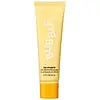What's inside
What's inside
 Key Ingredients
Key Ingredients

 Benefits
Benefits

 Concerns
Concerns

No concerns
 Ingredients Side-by-side
Ingredients Side-by-side

Zinc Oxide 12%
Cosmetic ColorantWater
Skin ConditioningIsoamyl Laurate
EmollientGlycerin
HumectantCaprylic/Capric Triglyceride
MaskingButyloctyl Salicylate
Skin ConditioningPolyglyceryl-10 Stearate
Skin ConditioningPoly C10-30 Alkyl Acrylate
Emulsion StabilisingPolyhydroxystearic Acid
EmulsifyingCetearyl Olivate
Sorbitan Olivate
EmulsifyingRubus Idaeus Seed Oil
EmollientPanax Ginseng Root Extract
EmollientTheobroma Cacao Seed Extract
AntioxidantHydroxyethyl Acrylate/Sodium Acryloyldimethyl Taurate Copolymer
Emulsion StabilisingHydroxyacetophenone
AntioxidantPolyglyceryl-10 Laurate
Skin ConditioningMicrocrystalline Cellulose
AbsorbentButylene Glycol
HumectantXanthan Gum
EmulsifyingCellulose Gum
Emulsion StabilisingPhenoxyethanol
PreservativeZinc Oxide 12%, Water, Isoamyl Laurate, Glycerin, Caprylic/Capric Triglyceride, Butyloctyl Salicylate, Polyglyceryl-10 Stearate, Poly C10-30 Alkyl Acrylate, Polyhydroxystearic Acid, Cetearyl Olivate, Sorbitan Olivate, Rubus Idaeus Seed Oil, Panax Ginseng Root Extract, Theobroma Cacao Seed Extract, Hydroxyethyl Acrylate/Sodium Acryloyldimethyl Taurate Copolymer, Hydroxyacetophenone, Polyglyceryl-10 Laurate, Microcrystalline Cellulose, Butylene Glycol, Xanthan Gum, Cellulose Gum, Phenoxyethanol
Butyl Methoxydibenzoylmethane 3%
UV AbsorberHomosalate 7%
Skin ConditioningEthylhexyl Salicylate 5%
UV AbsorberOctocrylene 9%
UV AbsorberWater
Skin ConditioningButyloctyl Salicylate
Skin ConditioningGlycerin
HumectantDicaprylyl Carbonate
EmollientDiisopropyl Adipate
EmollientSodium Stearoyl Glutamate
CleansingCocoglycerides
EmollientPropanediol
SolventMicrocrystalline Cellulose
AbsorbentTocopherol
AntioxidantBisabolol
MaskingCaprylyl Glycol
EmollientEthyl Ferulate
AntioxidantSodium Hyaluronate
HumectantGlyceryl Stearate Se
EmulsifyingMethylheptylglycerin
HumectantSodium Gluconate
Skin ConditioningCaprylhydroxamic Acid
Xanthan Gum
EmulsifyingPhospholipids
Skin ConditioningCellulose Gum
Emulsion StabilisingCitric Acid
BufferingGlycolipids
Skin ConditioningOlea Europaea Fruit Oil
MaskingAloe Barbadensis Leaf Juice
Skin ConditioningPhosphatidylserine
Emulsion StabilisingAstaxanthin
Skin ConditioningCeramide NP
Skin ConditioningCholesterol
EmollientHydrogenated Lecithin
EmulsifyingOleic Acid
EmollientPhytosphingosine
Skin ConditioningHaematococcus Pluvialis Extract
AntioxidantCaprylic/Capric Triglyceride
MaskingStearic Acid
CleansingSodium Benzoate
MaskingPotassium Sorbate
Preservative1,2-Hexanediol
Skin ConditioningBeta-Glucan
Skin ConditioningLactic Acid
BufferingButyl Methoxydibenzoylmethane 3%, Homosalate 7%, Ethylhexyl Salicylate 5%, Octocrylene 9%, Water, Butyloctyl Salicylate, Glycerin, Dicaprylyl Carbonate, Diisopropyl Adipate, Sodium Stearoyl Glutamate, Cocoglycerides, Propanediol, Microcrystalline Cellulose, Tocopherol, Bisabolol, Caprylyl Glycol, Ethyl Ferulate, Sodium Hyaluronate, Glyceryl Stearate Se, Methylheptylglycerin, Sodium Gluconate, Caprylhydroxamic Acid, Xanthan Gum, Phospholipids, Cellulose Gum, Citric Acid, Glycolipids, Olea Europaea Fruit Oil, Aloe Barbadensis Leaf Juice, Phosphatidylserine, Astaxanthin, Ceramide NP, Cholesterol, Hydrogenated Lecithin, Oleic Acid, Phytosphingosine, Haematococcus Pluvialis Extract, Caprylic/Capric Triglyceride, Stearic Acid, Sodium Benzoate, Potassium Sorbate, 1,2-Hexanediol, Beta-Glucan, Lactic Acid
 Reviews
Reviews

Ingredients Explained
These ingredients are found in both products.
Ingredients higher up in an ingredient list are typically present in a larger amount.
Butyloctyl Salicylate is a chemical UV filter structurally similar to octisalate. It is a photostabilizer, SPF booster, emollient and solvent. This ingredient helps evenly spread out ingredients.
According to a manufacturer, it is suitable for pairing with micro Titanium Dioxide, Zinc Oxide, and pigments.
Photostabilizers help stabilize UV-filters and prevents them from degrading quickly.
Learn more about Butyloctyl SalicylateThis ingredient is an emollient, solvent, and texture enhancer. It is considered a skin-softener by helping the skin prevent moisture loss.
It helps thicken a product's formula and makes it easier to spread by dissolving clumping compounds.
Caprylic Triglyceride is made by combining glycerin with coconut oil, forming a clear liquid.
While there is an assumption Caprylic Triglyceride can clog pores due to it being derived from coconut oil, there is no research supporting this.
Learn more about Caprylic/Capric TriglycerideCellulose Gum is a water-soluble polymer that comes from cellulose. It is used to change the texture of a product and to help stabilize emulsions.
As an emulsifier, cellulose gum specifically thicken the texture of water-based products.
This ingredient is considered hypoallergenic and non-toxic. Cellulose Gum can be found in cosmetics, food, and other household goods such as paper products.
Learn more about Cellulose GumGlycerin is already naturally found in your skin. It helps moisturize and protect your skin.
A study from 2016 found glycerin to be more effective as a humectant than AHAs and hyaluronic acid.
As a humectant, it helps the skin stay hydrated by pulling moisture to your skin. The low molecular weight of glycerin allows it to pull moisture into the deeper layers of your skin.
Hydrated skin improves your skin barrier; Your skin barrier helps protect against irritants and bacteria.
Glycerin has also been found to have antimicrobial and antiviral properties. Due to these properties, glycerin is often used in wound and burn treatments.
In cosmetics, glycerin is usually derived from plants such as soybean or palm. However, it can also be sourced from animals, such as tallow or animal fat.
This ingredient is organic, colorless, odorless, and non-toxic.
Glycerin is the name for this ingredient in American English. British English uses Glycerol/Glycerine.
Learn more about GlycerinMicrocrystalline Cellulose is another name for refined wood pulp. It is used as an emulsifier and mattifying ingredient. As an emulsifier, it helps keep ingredients together.
Water. It's the most common cosmetic ingredient of all. You'll usually see it at the top of ingredient lists, meaning that it makes up the largest part of the product.
So why is it so popular? Water most often acts as a solvent - this means that it helps dissolve other ingredients into the formulation.
You'll also recognize water as that liquid we all need to stay alive. If you see this, drink a glass of water. Stay hydrated!
Learn more about WaterXanthan gum is used as a stabilizer and thickener within cosmetic products. It helps give products a sticky, thick feeling - preventing them from being too runny.
On the technical side of things, xanthan gum is a polysaccharide - a combination consisting of multiple sugar molecules bonded together.
Xanthan gum is a pretty common and great ingredient. It is a natural, non-toxic, non-irritating ingredient that is also commonly used in food products.
Learn more about Xanthan Gum